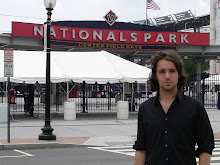So the Cincinnati Reds’ fairy-tale season has come to a sad end. It was perhaps inevitable but, for the neutral fan at least it’s never nice to see a plucky young team dumped so unceremoniously out of the playoffs by the more polished, more experience team they met in the form of the Philadelphia Phillies. Of course it would have taken a monumental comeback for the Reds to have come back to win a short series after the humiliation of getting so convincingly no-hit in the opener.
Despite feeling sorry for Dusty Baker’s team generally I must admit to feeling slightly smug whilst watching Aroldis Chapman blow game two after coming out of the bullpen to the usual pomp and circumstance. Why? Because he simply isn’t particularly effective and represents everything that is wrong with how we prize our pitchers.
Sure Chapman throws very, very hard and (according to his BB/K rate although he looks extremely hit or miss whenever I’ve watched him) has decent control, that’s all very impressive and makes for copy in sports publications. It does not however make him an effective pitcher. While only a few hitters are able to get around on a 105mph fastball, most will be able to make enough contact to foul one off. Speed will not necessarily get you outs, this has been proven time and time again and yet every time a new phenom emerges with a 100mph+ fastball the media goes gaga over it and common sense goes out of the window.
There is a lot of talk about Chapman becoming a starter next year. I can’t see how this will be a success. He simply doesn’t have the poise that other flame-throwing starters like Strasburg and Verlander do. Plus, how well will his arm hold up? I don’t think that one can even make the argument for Chapman that he will mature and grow into his position. He is, or at least should be a lot more seasoned than Stephen Strasburg was, he’d been a major star in Cuba for years, had travelled internationally and played in the WBC. That is worlds apart from Strasburg’s experience playing college ball. Yet it was Strasburg who made it to the show first, looking like a polished veteran whilst Chapman doesn’t appear until late in the year and, to my mind at least, looks more Joel Zumaya than Nolan Ryan.
Still, I don’t want to labour the Chapman-Strasburg comparison too much as its really not my point. The point of this post is to argue that neither of them are likely to enjoy success over a long period of time. History is not kind to flame-throwing starters. For every Nolan Ryan there are dozens of others who were either forced out of baseball through injury or returned as very different players. We should be very careful about prizing velocity over the other, more fundamental pitching skills. Nolan Ryan after all may have been one of the best pitchers of all time (strikeouts, no-hitters etc) but he was also, in many respects, one of the worst (all time BB leader, poor winning percentage).
Given Strasburg’s unusual poise and his vast assortment of secondary pitches he stands a very good chance of successfully returning from surgery but I think the days of 100mph fastballs are gone. With Strasburg’s range of pitches he simply doesn’t need to throw that hard to be successful, Josh Beckett doesn’t, Roy Halladay doesn’t, not even Tim Lincecum throws that hard – it just isn’t necessary. Chapman however seems to be all about velocity and this will hurt him, just like it killed Zumaya’s career.
Chapman has become a baseball side-show. People come to watch him throw 105mph, not to get people out. It was the same with Zumaya when he was throwing 104mph and yet was not consistent enough to wrestle the Tigers’ closer role from the likes of Todd Jones and Fernando Rodney (another speed merchant who you would never want pitching for your team with the game on the line).
It’s like boxing. It’s not about how hard you can punch your opponent, it’s about knowing his weaknesses and knowing when to punch your opponent. Take a look at the best pitchers of recent years: Glavine, Maddux, Mussina, Pettitte, Wells, Cone. None of them threw hard but they combined for two perfect games and a shelf full of Cy Young awards. Even the era’s hard-throwers: Johnson, Schilling, Clemens used their guile a lot more than today’s flame-throwers.
Baseball fans and writers would do well to remember George Carlin and his routine about the different between baseball and football. Brute force will not win you pennants. If that were the case then Mark Reynolds would be the MVP every year.
A League of Their Own is Heading to Television
7 years ago

